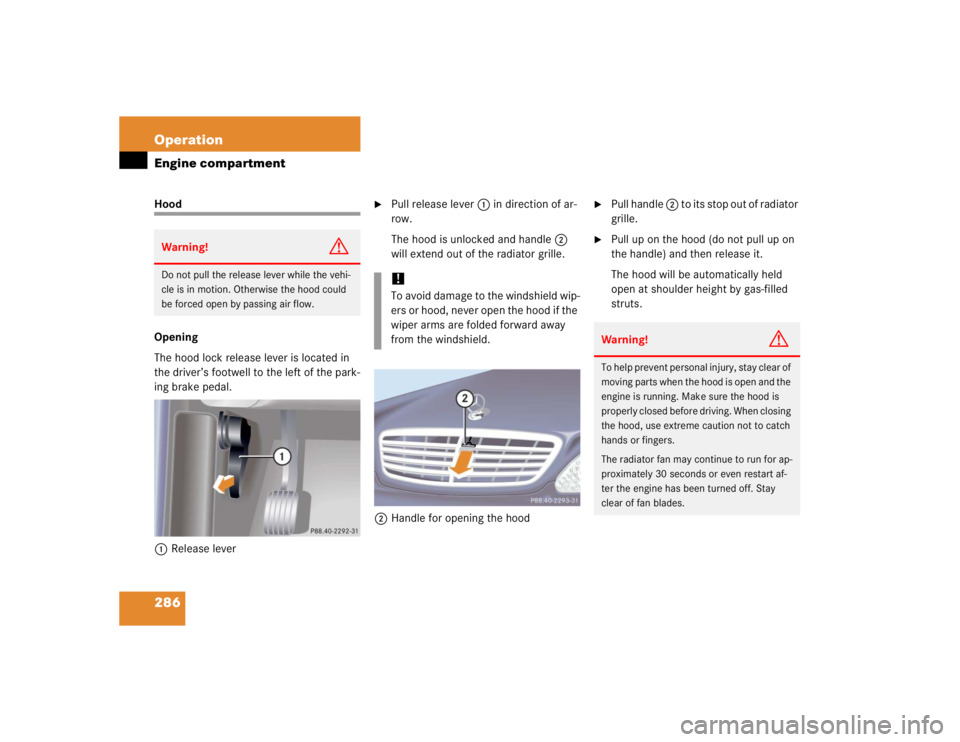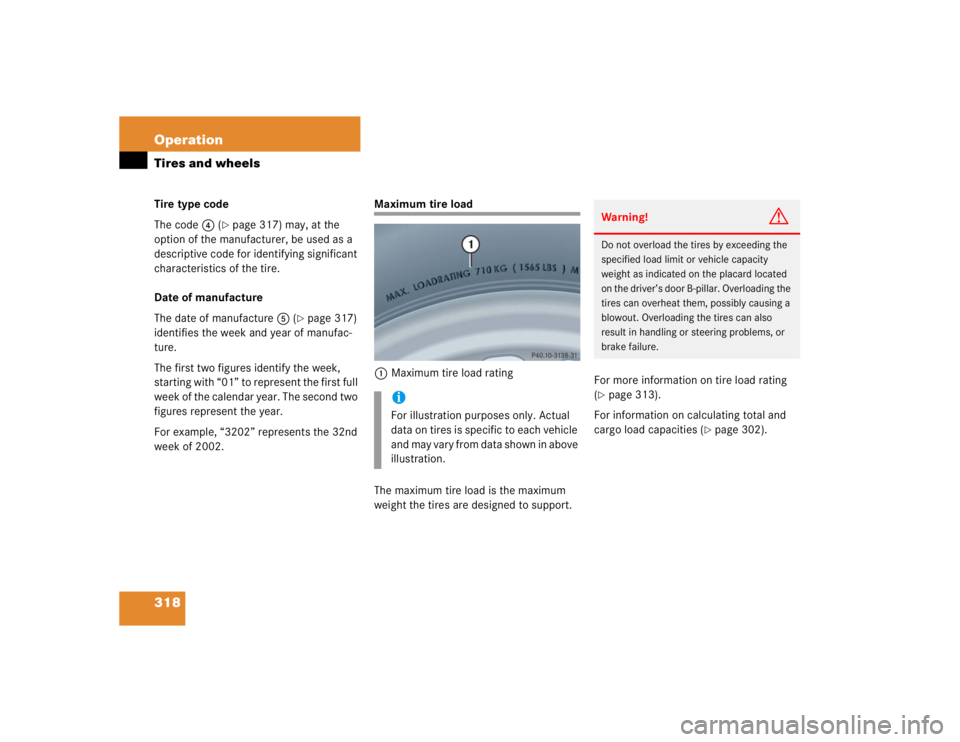Page 286 of 474

284 OperationAt the gas station�
Replace the fuel cap by turning it to the
right.
You will hear when the fuel cap is tight-
ened.
�
Close the fuel filler flap.
Check regularly and before a long trip
1Windshield washer and headlamp
cleaning system*
2Coolant level
3Brake fluid
Warning!
G
Overfilling of the fuel tank may create pres-
sure in the system which could cause a gas
discharge. This could cause the gas to spray
back out when removing the fuel pump noz-
zle, which could cause personal injury.
iOnly use premium unleaded gasoline
with a minimum Posted Octane Rating
of 91 (average of 96 RON/86 MON).
Information on gasoline quality can
normally be found on the fuel pump.
More information on gasoline can be
found in the Factory Approved Service
Products pamphlet.iLeaving the engine running and the fuel
cap open can cause the yellow engine
malfunction indicator lamp ?
(USA only),
±
(Canada only)
to illuminate.
For more information, see the “Practi-
cal hints” section (
�page 341).
iOpening the hood, see (
�page 286).
��
Page 287 of 474

285 Operation
At the gas station
Windshield washer system and head-
lamp cleaning system*
For more information on refilling the wash-
er reservoir, see “Windshield washer sys-
tem and headlamp cleaning system*”
(�page 295).
Coolant
For more information on coolant, see
“Coolant level” (
�page 292) and see “Fu-
els, coolants, lubricants, etc.”
(
�page 429).Brake fluid
For information on brake fluid, see “Brake
fluid” (
�page 431)Engine oil level
For more information on engine oil, see
“Engine oil” (
�page 287).
Vehicle lighting
Check function and cleanliness. For more
information on replacing light bulbs, see
“Replacing bulbs” (
�page 389).
For more information, see “Switching on
headlamps” (
�page 50).
Tire inflation pressure
For information on tire inflation pressure,
see “Checking tire inflation pressure”
(
�page 307).
!If you find that the brake fluid in the
brake fluid reservoir has fallen to the
minimum mark or below, have the
brake system checked for brake pad
thickness and leaks immediately.
Notify an authorized Mercedes-Benz
Center immediately. Do not add brake
fluid as this will not solve the problem.
For more information, see “Practical
hints” (
�page 339).
Page 288 of 474

286 OperationEngine compartmentHood
Opening
The hood lock release lever is located in
the driver’s footwell to the left of the park-
ing brake pedal.
1Release lever
�
Pull release lever 1 in direction of ar-
row.
The hood is unlocked and handle2
will extend out of the radiator grille.
2Handle for opening the hood
�
Pull handle 2 to its stop out of radiator
grille.
�
Pull up on the hood (do not pull up on
the handle) and then release it.
The hood will be automatically held
open at shoulder height by gas-filled
struts.
Warning!
G
Do not pull the release lever while the vehi-
cle is in motion. Otherwise the hood could
be forced open by passing air flow.
!To avoid damage to the windshield wip-
ers or hood, never open the hood if the
wiper arms are folded forward away
from the windshield.
Warning!
G
To help prevent personal injury, stay clear of
moving parts when the hood is open and the
engine is running. Make sure the hood is
properly closed before driving. When closing
the hood, use extreme caution not to catch
hands or fingers.
The radiator fan may continue to run for ap-
proximately 30 seconds or even restart af-
ter the engine has been turned off. Stay
clear of fan blades.
Page 298 of 474

296 OperationTires and wheelsSee an authorized Mercedes-Benz Center
for information on tested and
recommended rims and tires for summer
and winter operation. They can also offer
advice concerning tire service and
purchase.
Retreaded tires are not tested or recom-
mended by Mercedes-Benz, since previous
damage cannot always be recognized on
retreads. The operating safety of the
vehicle cannot be assured when such tires
are used.
See an authorized Mercedes-Benz Center
for information on tested and
recommended rims and tires for summer
and winter operation.
Important guidelines�
Only use sets of tires and rims of the
same type and make.
�
Tires must be of the correct size for the
rim.
�
Break in new tires for approximately
60 miles (100 km) at moderate
speeds.
�
Regularly check the tires and rims for
damage. Dented or bent rims can
cause tire inflation pressure loss and
damage to the tire beads.
�
If vehicle is heavily loaded, check tire
inflation pressure and correct as
required.
�
Do not allow your tires to wear down
too far. Adhesion properties on wet
roads are sharply reduced at tread
depths under
1/8in (3 mm).
�
When replacing individual tires, you
should mount new tires on the front
wheels first (on vehicles with
same-sized wheels all around).
Warning!
G
Replace rims or tires with the same designa-
tion, manufacturer and type as shown on the
original part. See an authorized
Mercedes-Benz Center for further informa-
tion. If incorrectly sized rims and tires are
mounted:�
The wheel brakes or suspension
components can be damaged.
�
The operating clearance of the wheels
and the tires may no longer be correct.
Warning!
G
Worn, old tires can cause accidents. If the
tire tread is badly worn, or if the tires have
sustained damage, replace them.
When replacing rims, only use genuine
Mercedes-Benz wheel bolts specified for the
particular rim type. Failure to do so can
result in the bolts loosening and possibly an
accident.
Page 302 of 474

300 OperationTires and wheels1Driver’s door B-pillar
Following is a discussion on how to work
with the information contained on the two
placards with regards to loading your vehi-
cle.Tire and Loading Information
Your vehicle is equipped with either the
Tire and Loading Information placard
(Example A) or the Vehicle Tire Information
placard (Example B). Placard (Example A)
1Load limit information on the Tire and
Loading Information placard
The placard showing the load limit informa-
tion is located on the driver's door B-pillar.
If your vehicle is equipped with the Tire and
Loading Information placard (Example A),
locate the statement “The combined
weight of occupants and cargo should
never exceed XXX kilograms or XXX lbs.”
on this placard. The combined weight of all
occupants, cargo / luggage and trailer
tongue load (if applicable) should never
exceed the weight referenced in that
statement.
Warning!
G
Do not overload the tires by exceeding the
specified load limit or vehicle capacity
weight as indicated on the placard on the
driver’s door B-pillar. Overloading the tires
can overheat them, possibly causing a
blowout. Overloading the tires can also
result in handling or steering problems, or
brake failure.iData shown on placard examples is for
illustration purposes only. Load limit
data is specific to each vehicle and may
vary from data shown in the illustra-
tions below. Refer to placard on vehicle
for actual data specific to your vehicle.
Page 311 of 474

309 Operation
Tires and wheels
iThe recommended tire inflation pres-
sures for your vehicle can be found on
the tire placard located on the driver’s
door B-pillar. The tire inflation pres-
sures are not listed in the owner’s man-
ual.Warning!
G
The tire inflation pressure monitor does not
indicate a warning for wrongly selected tire
inflation pressures. Always adjust tire infla-
tion pressure according to the placard on
the driver’s door B-pillar or, if available, the
inside of the fuel filler flap.
The tire inflation pressure monitor is not
able to issue a warning due to a sudden dra-
matic loss of tire inflation pressure (e.g. tire
blowout caused by a foreign object). In this
case bring the vehicle to a halt by carefully
applying the brakes and avoiding abrupt
steering maneuvers.
iOperating radio transmission equip-
ment (e.g. wireless headsets, two-way
radios) in or near the vehicle could
cause the tire inflation pressure moni-
tor to malfunction.
Warning!
G
Follow recommend tire inflation pressures.
Do not overinflate tires. Overinflating tires
can result in sudden deflation (blowout) be-
cause they are more likely to become punc-
tured or damaged by road debris, potholes,
etc.
Do not underinflate tires. Underinflated tires
wear unevenly, adversely affect handling
and fuel economy, and are more likely to fail
from being overheated.
Do not overload the tires by exceeding the
specified load limit or vehicle capacity
weight as indicated on the placard on the
driver’s door B-pillar. Overloading the tires
can overheat them, possibly causing a
blowout.
Page 316 of 474

314 OperationTires and wheels
For additional information on tire load
rating, see “Load identification”
(�page 316).Tire speed rating
The tire speed rating6 (
�page 312)
indicates the approved maximum speed
for the tire.
Warning
G
The tire load rating must always be at least
half of the GAWR (
�page 322) of your vehi-
cle. Otherwise, tire failure may be the result
which may cause an accident and/or seri-
ous personal injury to you or others.
Always replace rims and tires with the same
designation, manufacturer and type as
shown on the original part.
Warning!
G
Do not overload the tires by exceeding the
specified load limit or vehicle capacity
weight as indicated on the placard located
on the driver's door B-pillar. Overloading the
tires can overheat them, possibly causing a
blowout. Overloading the tires can also
result in handling or steering problems, or
brake failure.
iTire load rating5 (
�page 312) and
Tire speed rating6 (�page 312) are
also referred to as “service descrip-
tion”.
Warning!
G
Even when permitted by law, never operate
a vehicle at speeds greater than the
maximum speed rating of the tires.
Exceeding the maximum speed for which
tires are rated can lead to sudden tire
failure, causing loss of vehicle control and
possibly resulting in an accident and/or
personal injury and possible death, for you
and for others. iTire load rating5 (
�page 312) and
Tire speed rating6 (�page 312) are
also referred to as “service descrip-
tion”.
Page 320 of 474

318 OperationTires and wheelsTire type code
The code4 (
�page 317) may, at the
option of the manufacturer, be used as a
descriptive code for identifying significant
characteristics of the tire.
Date of manufacture
The date of manufacture5 (
�page 317)
identifies the week and year of manufac-
ture.
The first two figures identify the week,
starting with “01” to represent the first full
week of the calendar year. The second two
figures represent the year.
For example, “3202” represents the 32nd
week of 2002.
Maximum tire load
1Maximum tire load rating
The maximum tire load is the maximum
weight the tires are designed to support.For more information on tire load rating
(
�page 313).
For information on calculating total and
cargo load capacities (
�page 302).
iFor illustration purposes only. Actual
data on tires is specific to each vehicle
and may vary from data shown in above
illustration.
Warning!
G
Do not overload the tires by exceeding the
specified load limit or vehicle capacity
weight as indicated on the placard located
on the driver’s door B-pillar. Overloading the
tires can overheat them, possibly causing a
blowout. Overloading the tires can also
result in handling or steering problems, or
brake failure.